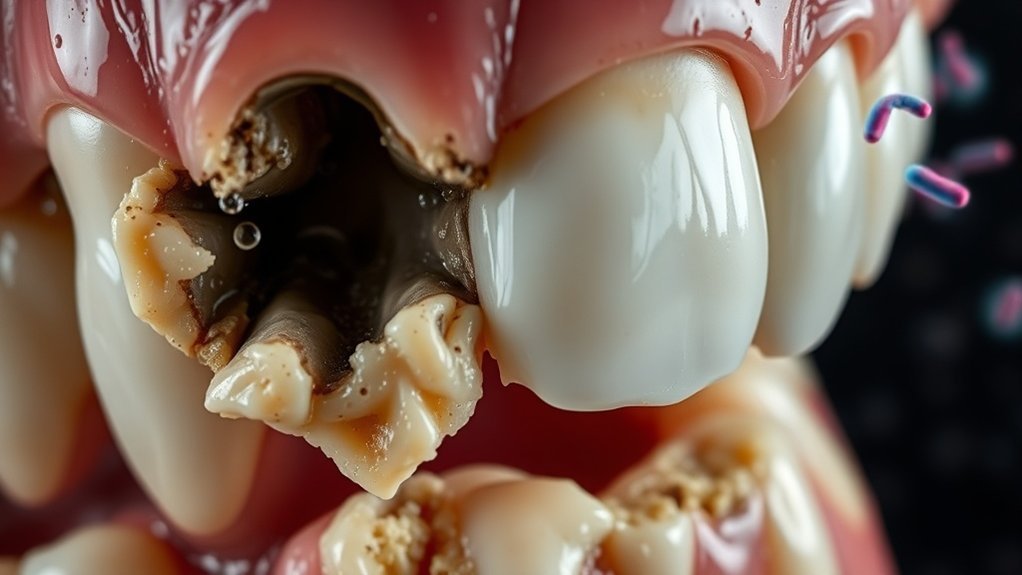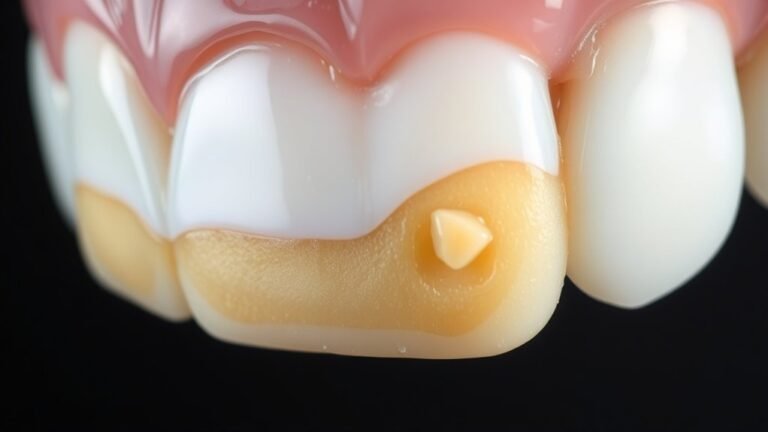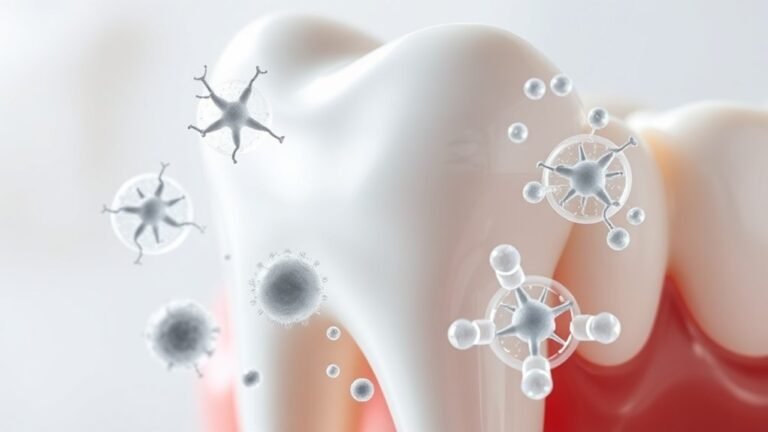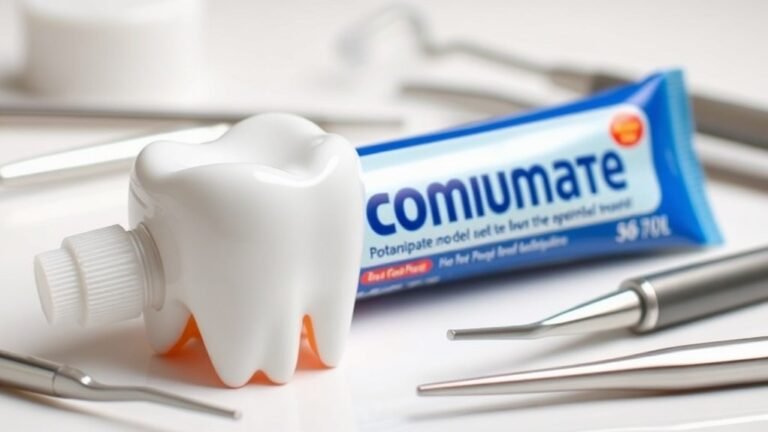How Quickly Do Bacteria Like Streptococcus Mutans Create Cavities
Streptococcus mutans begins the cavity formation process within days after it colonizes your tooth surfaces. It rapidly converts sugars into acids, leading to enamel demineralization and the creation of plaque. This biofilm not only protects S. mutans but also fosters a friendly environment for more bacteria, accelerating decay. Ignoring these early signs can result in deeper dental issues. Understanding the mechanics of this process is essential for effective prevention strategies.
Key Takeaways
- S. mutans can start demineralizing tooth enamel within days of sugar exposure.
- Plaque formation occurs within a few days after bacterial colonization.
- Continuous acid production from S. mutans accelerates cavity development.
- Without intervention, cavities can progress to dentin in weeks.
- Early signs of decay may take weeks to months to become noticeable.
The Role of Streptococcus Mutans in Tooth Decay
When you consume sugary foods, Streptococcus mutans, a primary bacterium in the oral cavity, quickly converts these sugars into acids. This acid production plays a significant role in tooth decay, as it leads to demineralization of the tooth enamel. Over time, continuous exposure to these acids creates an acidic environment that favors further bacterial growth and biofilm formation. As S. mutans adheres to the tooth surface, it forms a sticky plaque that protects it from saliva and immune responses. This process not only accelerates enamel erosion but also initiates the carious process. If left unchecked, the resulting cavities can lead to substantial dental issues. Understanding the role of S. mutans in tooth decay is essential for effective preventive strategies.
How S. Mutans Colonizes the Oral Cavity
The ability of Streptococcus mutans to colonize the oral cavity is a key factor in its role in tooth decay. It adheres to tooth surfaces using specific adhesins, forming a robust biofilm known as bacterial plaque. This plaque serves as a habitat for S. mutans, allowing it to thrive within the complex oral microbiome. The bacterium metabolizes fermentable carbohydrates, producing acids that demineralize enamel. Over time, as plaque accumulates, S. mutans can outcompete other microflora, establishing itself as a dominant species. This colonization not only promotes decay but also alters the microbial balance, leading to further complications. Understanding how S. mutans interacts with the oral cavity is essential for developing effective preventive measures against cavities.
Factors Influencing Cavity Formation
While various factors contribute to cavity formation, the interplay between diet, oral hygiene, and microbial composition is particularly significant. Each element can accelerate acid production, leading to tooth decay. Here are four key factors influencing cavity formation:
- Dietary Sugars: High sugar intake fuels bacteria like S. mutans, promoting rapid acid production.
- Oral Hygiene Practices: Inadequate brushing and flossing allow plaque accumulation, increasing acid exposure to teeth.
- Saliva Flow: Reduced saliva can impair remineralization, leaving teeth more susceptible to acid damage.
- Microbial Diversity: A balanced oral microbiome can inhibit pathogenic bacteria, while an imbalance favors cavity-causing strains.
Understanding these factors helps you take proactive steps in preventing cavities and maintaining oral health.
The Timeline of Cavity Development
Cavity development follows a distinct timeline, beginning with the initial demineralization of enamel and culminating in advanced decay if left untreated. This process starts when bacteria, particularly Streptococcus mutans, form a biofilm on tooth surfaces. Within days to weeks, acidic byproducts from bacterial metabolism lead to the demineralization of enamel, marking the onset of dental caries. If you neglect proper oral hygiene, the biofilm thickens, and decay progresses into dentin. Over months, the enamel becomes increasingly compromised, resulting in visible cavities. Without intervention, the decay can penetrate deeper, reaching the pulp and causing severe pain. Understanding this timeline highlights the importance of timely dental care to prevent irreversible damage.
Preventive Measures Against Tooth Decay
Effective preventive measures against tooth decay are essential for maintaining oral health and reducing the risk of cavities. By proactively managing factors that lead to enamel erosion and sugar feeding, you can greatly enhance your dental wellbeing. Here are four key strategies:
- Limit Sugar Intake: Reduce consumption of sugary foods and beverages, which feed harmful bacteria.
- Practice Good Oral Hygiene: Brush twice daily and floss regularly to remove plaque buildup.
- Use Fluoride Products: Incorporate fluoride toothpaste and mouth rinses to strengthen enamel and resist decay.
- Regular Dental Check-ups: Visit your dentist for routine exams and cleanings to catch early signs of decay.
Frequently Asked Questions
Can S. Mutans Survive in Non-Acidic Environments?
S. mutans can survive in non-acidic environments, though its growth and metabolism are optimized for acidic conditions. In neutral pH, its activity diminishes, but it can persist by utilizing alternative energy sources.
How Does Diet Affect S. Mutans Activity?
Your diet greatly influences S. mutans activity. High sugar intake promotes acid production, enhancing bacterial growth. Conversely, a balanced diet rich in fiber and low in sugars can reduce their proliferation and cavity formation.
Are There Genetic Factors Influencing Cavity Susceptibility?
Yes, genetic factors can influence your cavity susceptibility. Variations in genes related to saliva composition, immune response, and enamel strength affect how effectively your body resists bacterial colonization and acid production, impacting cavity formation.
Can S. Mutans Be Completely Eliminated From the Mouth?
You can’t completely eliminate S. mutans from your mouth; “a stitch in time saves nine.” Instead, focus on maintaining oral hygiene and a balanced diet to manage their levels and reduce cavity risk effectively.
What Role Does Saliva Play in Cavity Prevention?
Saliva plays an important role in cavity prevention by neutralizing acids, providing essential minerals for enamel repair, and facilitating the removal of food particles and bacteria, thereby maintaining oral health and reducing cavity risk effectively.
Conclusion
In the grand theater of oral health, Streptococcus mutans plays the villain, swiftly crafting cavities like an artist with a brush. Once it sets up camp in your mouth, it begins its destructive work, often within a matter of weeks. However, by wielding the tools of prevention—proper oral hygiene, balanced diet, and regular dental visits—you can rewrite the script, transforming this tale of decay into one of triumph. Your smile deserves a heroic narrative, so take charge and protect it.






